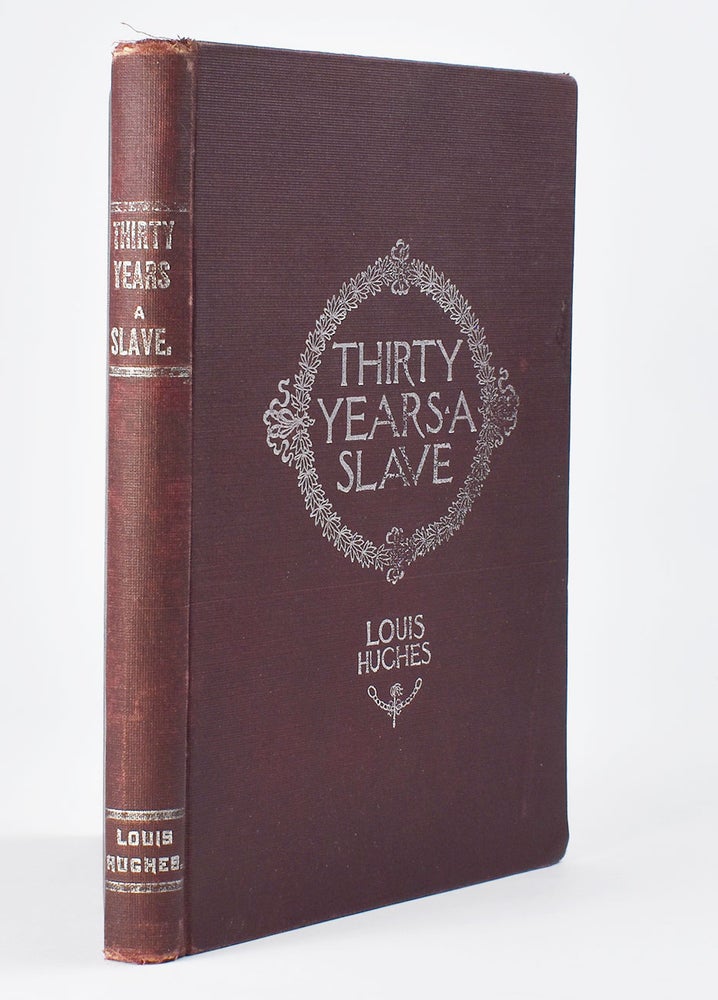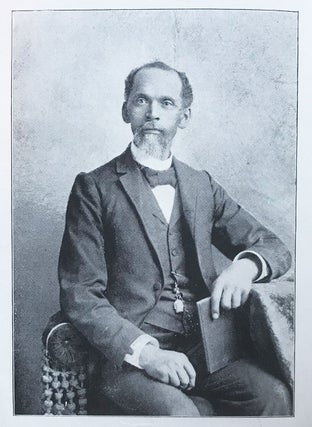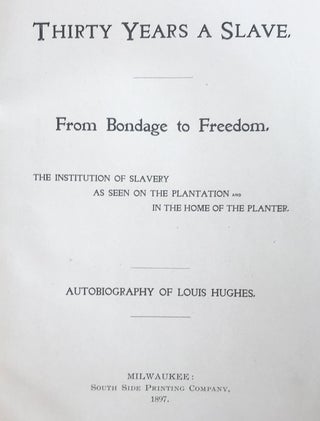Thirty Years a Slave: From Bondage to Freedom: The Institution of Slavery as Seen on the Plantation and in the Home of the Planter.
Milwaukee: South Side Printing Company, 1897. 8vo (8.5” x 6.25”), burgundy cloth stamped in silver. Frontis., 210 pp., 7 b&w plates of antebellum and Confederate currency. The rare autobiography of Louis Hughes, who was born into slavery, escaped near the end of the Civil War, and after the war worked as a professional nurse, having acquired his initial knowledge of medicine from his owner while a slave. Louis Hughes (1832–1913) was born on a plantation outside of Charlottesville, Virginia to a white man and an enslaved woman, was sold multiple times, and, despite five escape attempts, remained a slave until the closing days of the Civil War. Hughes's narrative details the daily lives of slaves; the hardships they suffered; observations of the Civil War from behind Confederate lines; the complex relationships between slaves and masters; graphic accounts of the physical abuse slaves endured, and details about slave markets, slave religion, and the organization of plantation work. Hughes also recounts the desire for learning he felt as a slave, and describes various tasks he performed in his master's households, which included nursing his fellow slaves. Separated from his mother in his youth, Hughes was traded among various slave-owners until being sold in 1844 (at the Richmond slave market) to his final master, one Mr. McGee of Pontotoc, Mississippi, a cotton planter with whom he remained until McGee's death in 1865. Serving initially as an errand boy and servant on McGee's plantation in Pontotoc on the Mississippi River, Hughes later received instruction from McGee—apparently a retired doctor—on various medicines and their properties, and used this knowledge to nurse his fellow slaves. In 1850, Hughes was sent to Memphis to help construct a second house for McGee; here he met Matilda Morgan, to whom he was married in 1858. Hughes attempted to escape from Memphis twice, but was captured both times. Late in the Civil War, Hughes and fellow slaves belonging to McGee were relocated to Tombigbee, Alabama where they labored at a salt works. In 1865, when Union troops entered northern Mississippi, Hughes fled to the Union lines, and with help succeeded in rescuing his wife and children. After the war, he and his wife reunited with several members of their family and lived in a number of Southern, Midwestern and Canadian cities, before finally settling in Milwaukee. Here Hughes worked as a professional nurse, drawing on skills he developed while treating his fellow slaves. His narrative touches upon the social and economic struggles his family endured after the war. In a foreword to a contemporary edition of Hughes’s narrative, William L. Andrews discusses the importance of the autobiography: “By paying a Milwaukee printer to publish the Autobiography of Louis Hughes, the former Alabama slave turned Wisconsin businessman was free to write about his experience in the South and the North in his own way. What he wrote identifies Hughes in several ways as more representative of the African American rank-and-file, both before and after slavery, than Douglass or most of the other celebrated fugitive slaves whose antebellum narratives have dominated our understanding of what slavery was like." OCLC records just six copies (the two recorded at the British Library in fact being one). REFERENCES: Catalogue of the Charles L. Blockson Afro-American Collection, 10128; Henderson, Harris. Louis Hughes, b. 1832 at docsouth.unc.edu; Thirty years a slave. From bondage to freedom at loc.gov CONDITION: Cracking to hinge but intact; wear to spine extremities, fading to spine text.
Item #6447
Sold




